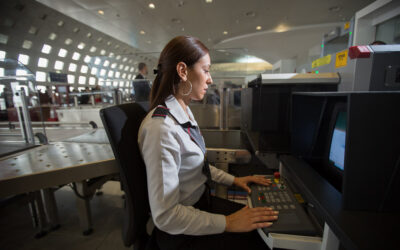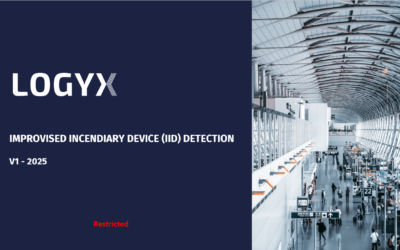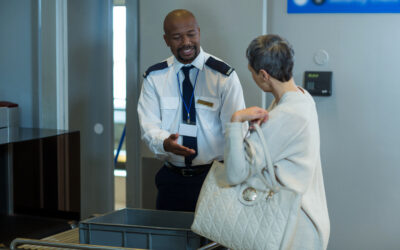LOGYX provides specialized training for railway security agents to enhance their skills in analyzing radioscopic images. This blog emphasizes the importance of railway security, especially at busy train stations, where specific measures are implemented for passenger and facility protection. The post discusses security measures such as access control systems, surveillance cameras, and random inspections to deter malicious activities. It also highlights recent changes in French legislation aimed at strengthening security in public transportation. LOGYX’s training, DETECT, focuses on X-ray devices, ensuring optimal knowledge for security personnel in screening baggage. This blog emphasizes the significance of standardized training to enhance detection capabilities and credibility in the railway security sector.
Railway security agents
Railway security, particularly at station entrances, is a major concern to ensure the safety of passengers, railway staff, and facilities. In the densely trafficked railway network of the Paris region, specific measures are implemented to enhance security.
Security agents are systematically deployed at stations to provide a deterrent presence and intervene swiftly when needed. They assist passengers and coordinate security operations. Stations are typically equipped with access control systems (security gates, turnstiles) and video surveillance systems to monitor entry zones and public areas. These cameras enable real-time monitoring and allow the investigation of potential incidents. Random inspections and searches are conducted to deter malicious activities and detect prohibited or potentially dangerous items. Railway companies often collaborate with local law enforcement to enhance security through joint patrols and emergency response plans.
The case of international trains such as Eurostar and Thalys is unique; generally, for these trains, security checks are conducted before passengers board. These checks may include X-ray scanners to inspect carry-on luggage. These security measures aim to ensure the safety of passengers and prevent any risks associated with dangerous or prohibited items. However, the exact procedures may vary depending on current regulations and the specific practices of each railway company. In general, passengers are required to undergo a security check similar to airport procedures, with X-ray scanners for carry-on luggage and metal detectors for passengers.
Changing regulations
On February 13, 2024, the Senate passed a bill aimed at strengthening security in transportation, acknowledging deteriorating safety conditions and a prevalent terrorist threat due to the organization of the 2024 Olympic and Paralympic Games. The proposed law seeks to empower internal security agents of transport operators, enhance security continuity, leverage technology for transport security, better prosecute transport-related offenses, secure recruitment and assignments in transport, and streamline the data reliability verification procedure.
The Senate introduces significant changes in public transportation security. Internal security agents of the SNCF (SUGE – General Surveillance) and the RATP can now conduct security pat-downs without a prefectural order if there are objective elements suggesting a person may possess dangerous items. Additionally, these agents are authorized to remove discovered dangerous objects during preventive searches. A new prohibition on entry to stations targets individuals whose behavior disrupts public order, compromising safety or circulation regularity thresholds. Furthermore, all railway companies must establish a unique hotline for passengers to quickly report situations posing a risk to their safety or that of others.
The importance of training
Security agents stationed at station entrances increasingly rely on X-ray devices. Radioscopic imaging, in a security context, refers to the use of radiography or explosive detection systems (EDS) to visually inspect the contents of objects, luggage, or parcels without physically opening them. These devices are commonly used in places such as airports, government facilities, embassies, conference centers, and other high-security areas.
Despite the necessity for agents to use these devices, there is a lack of precise regulatory guidelines (such as hourly volume) leading to deficiencies in training. LOGYX offers training on these devices, providing optimal and comprehensive knowledge of equipment to effectively meet the security demands of French stations.
Training with LOGYX
LOGYX offers initial training, safety equipment training, and essential knowledge in general security. Periodic training is also provided to maintain acquired knowledge and skills. Agents practice on the LOGYX DETECT simulator for skills maintenance.
With LOGYX DETECT, agents can be trained and certified in radioscopic imaging. Personnel have access to training on the use of the latest generation security equipment – 2D single/dual-view and 3D. Images for training are sourced from real luggage and various partners worldwide to create exercises closely resembling real-world scenarios, regardless of the agent’s location or the area to be secured. Training can be conducted in-person or online.
Towards the standardization of training
Through its DETECT solution, LOGYX aims to enhance the detection capabilities of individuals working in the railway industry. LOGYX’S training has demonstrated increased performance among personnel in various sectors such as airports and ports. Standardized imaging training develops recognition and credibility within a professional community, and LOGYX can assist in this process. Let’s connect: contact@logyx.fr



